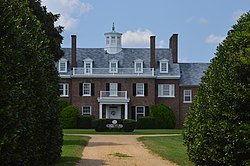Bushfield (Mount Holly, Virginia)
Bushfield | |
 Front of the house | |
 | |
| Location | 367 Club House Loop, Mount Holly, Virginia |
|---|---|
| Coordinates | 38°8′0″N 76°42′51″W / 38.13333°N 76.71417°WCoordinates: 38°8′0″N 76°42′51″W / 38.13333°N 76.71417°W |
| Area | 4 acres (1.6 ha) |
| Built | 1916 |
| Architect | Waddy Butler Wood, Richardson & Burgess, Inc. |
| Architectural style | Colonial Revival |
| NRHP reference No. | 04000053[1] |
| VLR No. | 096-0052 |
| Significant dates | |
| Added to NRHP | February 11, 2004 |
| Designated VLR | October 5, 2003[2] |
Bushfield, also known as Bushfield Manor, is a historic plantation house located at Mount Holly, Westmoreland County, Virginia.[3] Although the original plantation house dated to the 18th century, it was burned to the ground by the British in 1814. Its National Register of Historic Places listing in 2004 is based on its 1916 renovation discussed below. The brick dwelling now has two-stories and five-bays, with a center-passage, and single-pile dwelling. Also on the property are a contributing Bungalow-style caretaker's House, barn, silo, and cemetery. [4]
History[]
Bushfield, on Nomini Creek, was the family plantation of John Bushrod, whose father (of the same name) had bought it from Rice Maddox. Hannah Bushrod (daughter of the former Mildred Corbin, who married the younger John Bushrod) married John Augustine Washington in 1756. Bushfield was about 20 miles down the King's Highway from the oldest Washington family plantation -- 700 acres called "Head of Maddox" (meaning Mattox Creek, a tributary of the Potomac River), which Augustine Washington in 1743 willed to that same John Augustine Washington, his younger son. While his older brother George Washington was surveying western lands, John Augustine Washington brought his bride to Mount Vernon further up the Potomac River, then managed that plantation until George Washington married Martha Custis and brought her to Mount Vernon, which John Augustine Washington left in September 1761, after selling his brother some cattle.
John and Hannah Washington would have sons Bushrod and Corbin Washington, and daughters Mary and Jenny, the former born at Bushfield. John Bushrod by his February 1760 will (admitted to probate by the end of that year) bequeathed Bushfield, its land, furniture and 35 slaves to Hannah Bushrod Washington, and three slaves each to his granddaughters Mary and Jenny.[5] John A. Washington and his family visited Mount Vernon many times between 1760 and John's death on January 10, 1787, the last recorded being a three day visit in October 1786. John A. Washington had given his son Bushrod 41 slaves as a marriage deed of gift, which specified they would be deducted from his share of the estate. John Washington then wrote a will in 1784 (that gave his widow dower rights in 1/3 of his slaves (some named) and divided his land among his sons Bushrod and Corbin Washington, among other specified legacies) and a codicil in November 1785--which were both admitted to probate in Westmoreland County on July 31, 1787. In addition to his Westmoreland County plantations, John A. Washington had purchased 213 acres near and town lots in Berkeley Springs.[6]
Many Bushrods, as well as John Augustine Washington, and Corbin Washington and his wife (the former Hannah Lee) would all be buried at Bushfield, although Corbin and his wife both died in Fairfax County in the winter of 1799-1800. Although most of the gravestones were missing in the Bushfield graveyard in 1944,[7] replacement markers were added, so 14 graves are known.[8]
Bushrod Washington sold Bushfield in 1804, and it was resold several times by the century's end.[9] British ships in the Potomac River shelled the Bushfield plantation house in 1814, and it burned to the ground, but was rebuilt.[10]
Renovation[]
In 1916, prominent Chicagoan Mark Skinner Willing, heir to the Marshall Field retailing fortune, hired architect Waddy Butler Wood, who renovated and enlarged the dwelling in the Colonial Revival style, expanding an existing dwelling on both sides, with side gable roofs. A portico and lantern reflect the property's association with the family of George Washington.[1] Waddy Butler Wood's father was from Virginia, and although the architect was born in St. Louis, Missouri, he was raised in Gloucester County, Virginia and educated at Virginia Tech.[11] In the early 20th century, Wood became a prominent architect in the national capital area, for both government and private buildings. He preferred the Colonial Revival style and had earlier renovated the interior of another former Washington family house, Woodlawn.[12]
References[]
- ^ a b "National Register Information System". National Register of Historic Places. National Park Service. July 9, 2010.
- ^ "Virginia Landmarks Register". Virginia Department of Historic Resources. Archived from the original on 2013-09-21. Retrieved 5 June 2013.
- ^ John W, Wayland (1944). The Washingtons and their Homes. Staunton: McCLure Printing, later reprinted by Berryville, Va: Virginia Book Company
- ^ Kimble A. David (September 2003). "National Register of Historic Places Inventory/Nomination: Bushfield" (PDF). Virginia Department of Historic Resources. and Accompanying four photos
- ^ Wayland pp. 111-115
- ^ Wayland pp. 121-125
- ^ Wayland pp. 125-126
- ^ nris p.9-10
- ^ NRIS pp. 11-12
- ^ Wayland p. 125
- ^ NRIS p. 13
- ^ NRIS pp. 12-13
- Washington family residences
- Plantation houses in Virginia
- Houses on the National Register of Historic Places in Virginia
- Colonial Revival architecture in Virginia
- Houses completed in 1916
- Houses in Westmoreland County, Virginia
- National Register of Historic Places in Westmoreland County, Virginia
- Chesapeake Bay, Virginia Registered Historic Place stubs
- Westmoreland County, Virginia geography stubs



